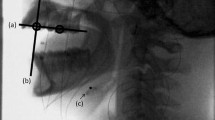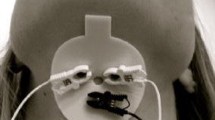Abstract
Electrophysiological assessment provides valuable information on physiological and pathophysiological characteristics of human swallowing. Here, new electrophysiological measures for the evaluation of oropharyngeal swallowing were assessed: (1) the activation pattern of the submental/suprahyoid EMG activity (SHEMG); (2) the reproducibility of the oral and pharyngeal phases of swallowing, by calculating the similarity index (SI) of the SHEMG (SI-SHEMG) and of the laryngeal–pharyngeal mechanogram (SI-LPM) during repeated swallows; and (3) kinesiological measures related to the LPM. An electrophysiological–mechanical method for measuring the activation pattern of the SHEMG, the SI-SHEMG, and the SI-LPM, and maximal LPM velocity and acceleration during swallowing was applied in 65 healthy subjects divided into three age groups (18–39, 40–59, 60 years or over). All the measures were assessed during three trials of eight consecutive swallows of different liquid bolus volumes (3, 12, and 20 ml). A high overall reproducibility of oropharyngeal swallowing in healthy humans was recorded. However, while values of SI-SHEMG were similar in all the age groups, the SI-LPM was found to fall significantly in the older age group. Both the SI-SHEMG and the SI-LPM were found to fall with increasing bolus volumes. The activation pattern of the SHEMG and the LPM kinesiological measures were differently modified by bolus volume and age in the older subjects with respect to the others. We describe a new approach to the electrophysiological study of swallowing based on computed semi-automatic analyses. Our findings provide insight into some previously uninvestigated aspects of oropharyngeal swallowing physiology, considered in relation to bolus volume and age. The new electrophysiological measures here described could prove useful in the clinical setting, as it is likely that they could be differently affected in patients with different kinds of dysphagia.







Similar content being viewed by others
Abbreviations
- SHEMG:
-
EMG activity of the submental/suprahyoid muscles
- SHEMG-E:
-
Envelope of the submental/suprahyoid EMG activity
- T-shape:
-
Triangular ‘theoretical’ reference shape
- SHEMG-E/T-shape:
-
Analytical comparison between SHEMG-E and T-shape
- SI:
-
Similarity index
- LPM:
-
Laryngeal–pharyngeal mechanogram
- SI-SHEMG-E:
-
Similarity index of the SHEMG-E
- SI-LPM:
-
Similarity index of the LPM
- LPM-V max :
-
Maximal velocity of the LPM
- LPM-Acmax :
-
Maximal acceleration of the LPM
- MUs:
-
Motor units
References
Ertekin C, Aydoğdu I, Yüceyar N, Pehlivan M, Ertaş M, Uludağ B, Celebi G. Effects of bolus volumes on the oropharyngeal swallowing: an electrophysiological study in man. Am J Gastroenterol. 1997;11:2049–53.
Perlman AL, Palmer PM, McCulloch TM, Van Daele JD. Electromyographic activity from human laryngeal, pharyngeal, and submental muscles during swallowing. J Appl Physiol. 1999;86:1663–9.
Dind R, Logemann JA, Larson CR, Rademaker AW. The effects of taste and consistency on swallow physiology in younger and older healthy individuals: a surface electromyographic study. J Speech Lang Hear Res. 2003;46:977–89.
Vaiman M, Eviatar E, Segal S. Evaluation of normal deglutition with the help of rectified surface electromyography. Dysphagia. 2004;19:125–32.
Miyaoka Y, Ashida I, Kawakami S, Tamaki Y, Miyaoka S. Activity patterns of the suprahyoid muscles during swallowing of different fluid volumes. J Oral Rehabil. 2010;37:575–82.
Nilsson H, Ekberg O, Olsson R, Hindfelt B. Quantitative aspects of swallowing in an elderly nondysphagic population. Dysphagia. 1996;11:180–4.
Ertekin C, Keskin A, Kiylioglu N, Kirazli Y, On AY, Tarlaci S, Aydoğdu I. The effect of head and neck positions on oropharyngeal swallowing: a clinical and electrophysiological study. Arch Phys Med Rehabil. 2001;82:1255–60.
Cichero J. Swallowing from infancy to old age. In: Cichero JAY, Murdoch BE, editors. Dysphagia. Foundation, theory and practice, vol. 6. Chichester: Wiley; 2006. p. 26–46.
Sahin Sağlam AM, Uydas NE. Relationship between head posture and hyoid position in adult females and males. J Craniomaxillofac Surg. 2006;34:85–92.
Inagaki D, Miyaoka Y, Ashida I, Ueda K, Yamada Y. Influences of body posture on duration of oral swallowing in normal young adults. J Oral Rehabil. 2007;34:414–21.
Sakuma T, Kida I. Relationship between ease of swallowing and deglutition-related muscle activity in various postures. J Oral Rehabil. 2010;37:583–9.
Logemann JA. Evaluation and treatment of swallowing disorders. Austin: ProED; 1983.
Ertekin C, Pehlivan M, Aydoğdu I, Ertaş M, Uludağ B, Celebi G, Colakoğlu Z, Sağduyu A, Yüceyar N. An electrophysiological investigation of deglutition in man. Muscle Nerve. 1995;18:1177–86.
Alfonsi E, Versino M, Merlo IM, Pacchetti C, Martignoni E, Bertino G, Moglia A, Tassorelli C, Nappi G. Electrophysiologic patterns of oral-pharyngeal swallowing in parkinsonian syndromes. Neurology. 2007;68:583–9.
Kahrilas PJ, Logemann JA. Volume accommodation during swallowing. Dysphagia. 1993;8:259–65.
Crary MA, Carnaby Mann GD, Groher ME. Biomechanical correlates of surface electromyography signals obtained during swallowing by healthy adults. J Speech Lang Hear Res. 2006;49(1):186–93.
Inman VT, Ralston HJ, Sauders JB, Feinstein B, Wright EW Jr. Relation of human electromyogram to muscular tension. Electroencephalogr Clin Neurophysiol. 1952;4:187–94.
Jean A. Brainstem control of swallowing: neural network and cellular mechanisms. Physiol Rev. 2001;81:929–69.
Takahashi K, Groher M, Michi K. Symmetry and reproducibility of swallowing sounds. Dysphagia. 1994;9:168–73.
Pinnington LL, Ellis RE. Reproducibility of swallowing over time in healthy elderly adults. Dysphagia. 2006;2006:1–6.
Faes L, Nollo G, Antolini R, Gaita F, Ravelli F. A method for quantifying atrial fibrillation organization based on wave-morphology similarity. IEEE Trans Biomed Eng. 2002;49:1504–13.
Mainardi L, Sornmo L, Cerutti S. Understanding atrial fibrillation: the signal processing contribution. San Francisco: Morgan & Claypool Publishers; 2008.
Babaei A, Ward BD, Siwiec RM, Ahmad S, Kern M, Nencka A, Li SJ, Shaker R. Functional connectivity of the cortical swallowing network in humans. Neuroimage. 2013;76:33–44.
Michou E, Hamdy S. Cortical input in control of swallowing. Curr Opin Otolaryngol Head Neck Surg. 2009;17(3):166–71.
Sörös P, Inamoto Y, Martin RE. Functional brain imaging of swallowing: an activation likelihood estimation meta-analysis. Hum Brain Mapp. 2009;30:2426–39.
Ertekin C, Aydoğdu I, Yűceyar N. Piecemeal deglutition and dysphagia limit in normal subjects and in patients with swallowing disorders. J Neurol Neurosurg Psychiatry. 1996;61:491–6.
Dantas RO, Kern MK, Massey BT, Dodds WJ, Kahrilas PJ, Brasseur JG, Cook IJ, Lang IM. Effect of swallowed bolus variables on oral and pharyngeal phases of swallowing. Am J Physiol. 1990;258:G675–81.
Aviv JE, Martin JH, Jones ME, Wee TA, Diamond B, Keen MS, Blitzer A. Age-related changes in pharyngeal and supraglottic sensation. Ann Otol Rhinol Laryngol. 1994;103:749–52.
Takamori M, Gutmann L, Shane SR, Morgantown WV. Contractile properties of human skeletal muscle. Normal and thyroid disease. Arch Neurol. 1971;25:535–46.
Buchthal F, Schmalbruch H. Motor unit of mammalian muscle. Physiol Rev. 1980;60(1):90–142.
Yao W, Fuglevand RJ, Enoka RM. Motor-unit synchronization increases EMG amplitude and decreases force steadiness of simulated contractions. J Neurophysiol. 2000;83(1):441–52.
Semmler JG. Motor unit synchronization and neuromuscular performance. Exerc Sport Sci Rev. 2002;30(1):8–14.
Bagust J, Lewis DM, Westerman RA. The properties of motor units in a fast and slow twitch muscle during post-natal development in the kitten. J Physiol. 1974;237:75–90.
De Luca CJ, Erim Z. Common drive of motor units in regulation of muscle force. Trends Neurosci. 1994;17:229–305.
De Luca CJ, Adam A, Wotiz R, Gilmore LD, Nawab SH. Decomposition of surface EMG signals. J Neurophysiol. 2006;96:1646–57.
Howard JE, McGill KC, Dorfman LJ. Age effects on properties of motor unit action potentials: ADEMG analysis. Ann Neurol. 1988;24:207–13.
Donner M, Jones B. Ageing and neurological disease. In: Jones B, Donner MW, editors. Normal and abnormal swallowing: imaging in diagnosis and therapy. New York: Springer; 1991.
Robbins J, Hamilton JW, Lof GL, Kempster GB. Oropharyngeal swallowing in normal adults of different ages. Gastroenterology. 1992;103:823–9.
Martin R, Barr A, MacIntosh B, Smith R, Stevens T, Taves D, Gati J, Menon R, Hachinski V. Cerebral cortical processing of swallowing in older adults. Exp Brain Res. 2007;176:12–22.
Malandraki GA, Bradley PS, Perlmann A, Karampinos DC. Age-related differences in laterality of cortical activations in swallowing. Dysphagia. 2010;25:238–49.
Humbert IA, Fitzgerald ME, McLaren DG, Johnson S, Porcaro E, Kosmatka K, Hind J, Robbins J. Neurophysiology of swallowing: effects of age and bolus type. Neuroimage. 2009;4:982–91.
Freund HJ, Büdingen HJ, Dietz V. Activity of single motor units from human forearm muscles during voluntary isometric contractions. J Neurophysiol. 1975;38(4):933–46.
Alfonsi E, Merlo IM, Ponzio M, Montomoli C, Tassorelli C, Biancardi C, Lozza A, Martignoni E. An electrophysiological approach to the diagnosis of neurogenic dysphagia: implications for botulinum toxin treatment. J Neurol Neurosurg Psychiatry. 2010;81:54–60.
Alfonsi E, Bergamaschi R, Cosentino G, Ponzio M, Montomoli C, Restivo DA, Brighina F, Ravaglia S, Prunetti P, Bertino G, Benazzo M, Fontana D, Moglia A. Electrophysiological patterns of oropharyngeal swallowing in multiple sclerosis. Clin Neurophysiol. 2013;124:1638–45.
Taniguchi H, Tsukada T, Ootaki S, Yamada Y, Inoue M. Correspondence between food consistency and suprahyoid muscle activity, tongue pressure, and bolus transit times during the oropharyngeal phase of swallowing. J Appl Physiol. 2008;105:791–9.
Acknowledgments
The authors wish to thank Ms. Catherine Wrenn for the linguistic revision of the manuscript. This study was supported by a Grant from the Italian Ministry of Health related to the Project “Presbyphagia: analysis of diagnostic criteria and identification of potential innovative treatments” RF-2010-231945.
Author information
Authors and Affiliations
Corresponding author
Ethics declarations
Conflict of interest
The authors report no conflicts of interest.
Rights and permissions
About this article
Cite this article
Alfonsi, E., Cosentino, G., Mainardi, L. et al. Electrophysiological Investigations of Shape and Reproducibility of Oropharyngeal Swallowing: Interaction with Bolus Volume and Age. Dysphagia 30, 540–550 (2015). https://doi.org/10.1007/s00455-015-9634-1
Received:
Accepted:
Published:
Issue Date:
DOI: https://doi.org/10.1007/s00455-015-9634-1




